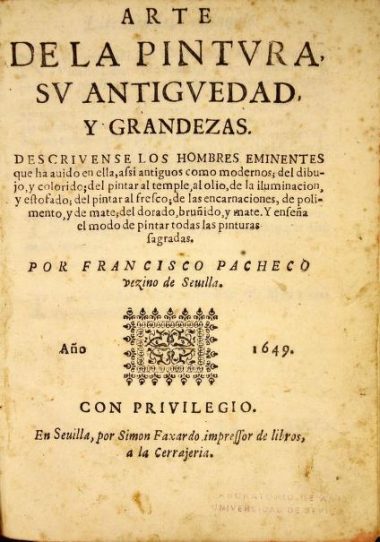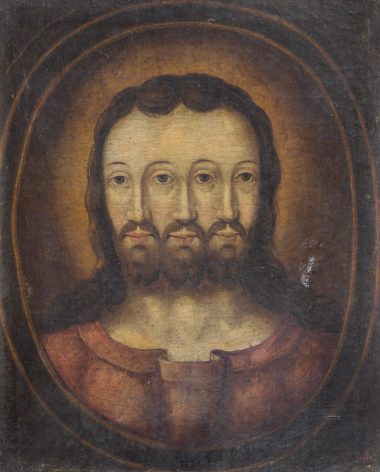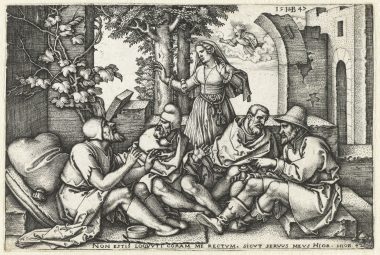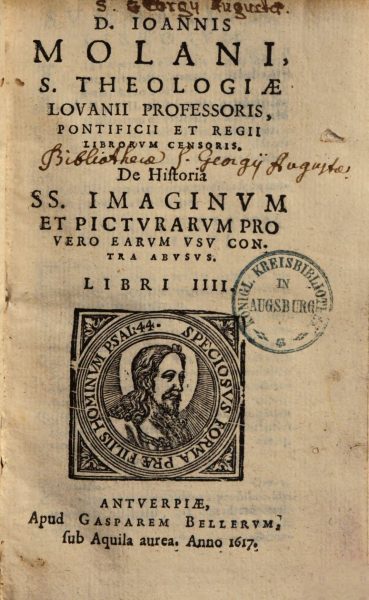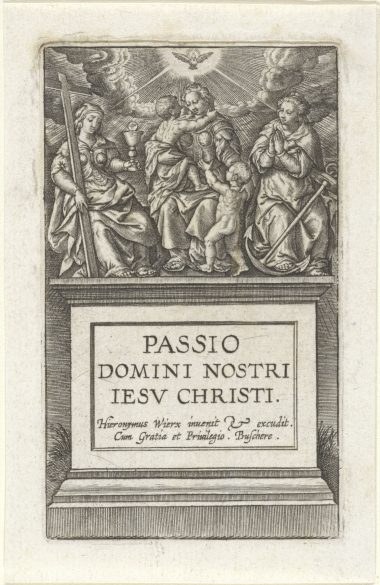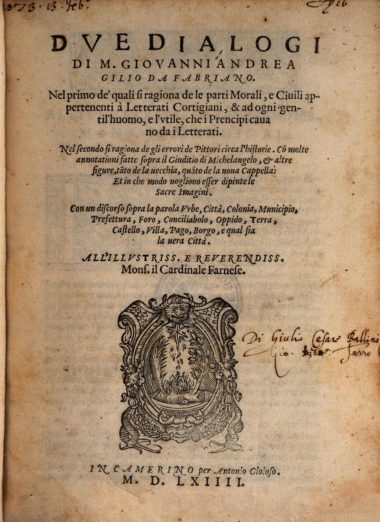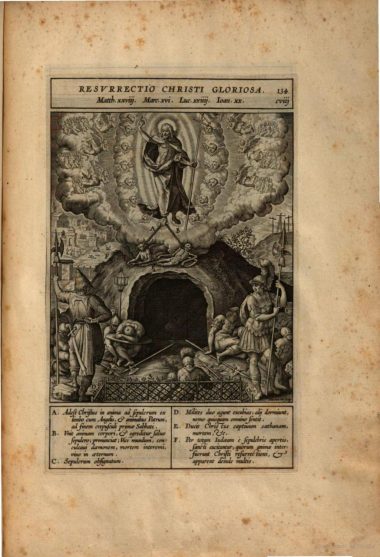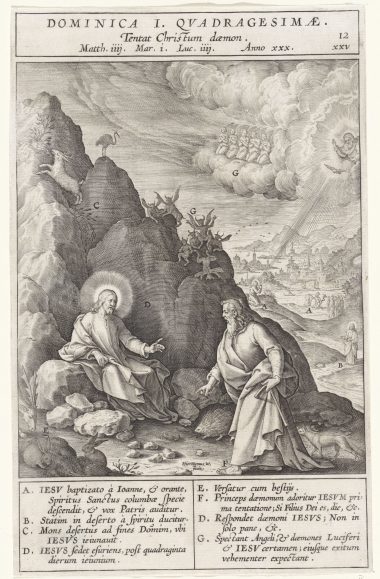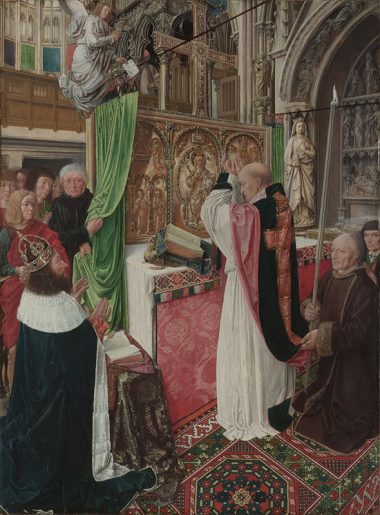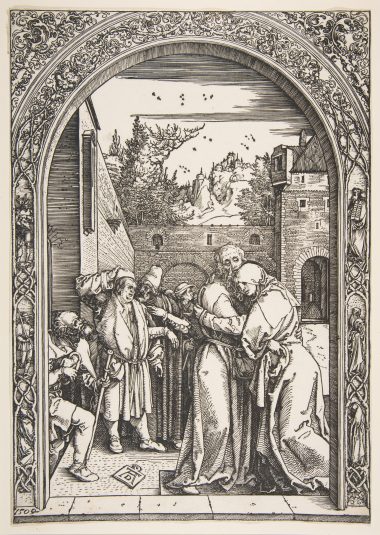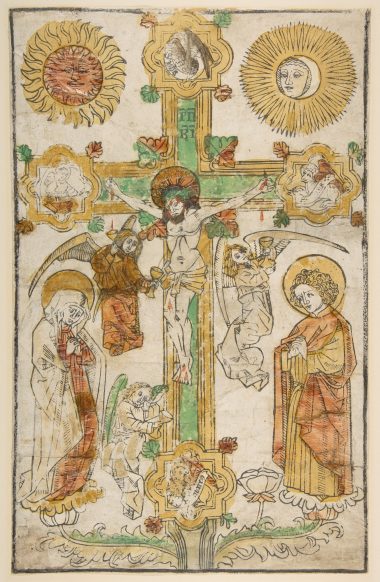Virgin Mary is who circumcised the Child Jesus
Pacheco states that the circumcision of the Christ-child was made by Virgin Mary. The author afterward declares that the way of painting this scene should be represented from that moment onwards, although he recognises the way of painting it might be seen as new.
Images of the Trinity as a man with three heads or with three faces is a diabolical invention
Molanus condemns a rather widespread way of depicting the Holy Trinity, namely their representation as one man with three heads or one head with three faces, which would be a monster of nature and a diabolical invention.
Job’s Friends Eliphaz, Bildad and Zophar were kings
Molanus condemns the depiction of Job’s friends as entertainers because in reality they were wise men.
Representation of saints should not give rise to quarrels and debate
Molanus pleads that the position of saints in painting should not lead to discussion and debate.
False criticism on the Three Godly Graces by a Calvinist
Molanus attacks Calvinsts’ claims of the inexistence and thus untruthfulness of the use of images of Fides, Spes, and Charitas.
Diego Gosqui does not believe what the Christians say of the crucifix and tramples over it
Diego Gosqui, a Morisco, does not believe in the image of the crucifix declaring ironically that if it had any power, it would rise.
The historic painter
In contrast to the poetic artist, the historical painter requires a higher level of skill.
Warning Christian painters of the correctness with which they should proceed
Pacheco warns the reader of his intentions in alerting Christian painters of the correctness with which they should proceed in painting the sacred stories.
How to depict the Resurrection of Christ (and how not to do it)
The Passion of Christ iconography was an important topic for Pacheco. When the author analysed the scene of the “Resurrection”, among several observations on how to do it, he states the inadequate manners to depict such a scene: the tomb of Christ opened and Christ takes one leg out to get out of it around it, also the terrified guards covering themselves, some with their shields and, behind, reaching for their swords. All these elements should be avoided.
Tempter of Christ in the wilderness
Molanus discusses whether the stones Christ turned into bread were handed by him by the tempter or whether they were on the ground.
The Virgin Mary showing her breast to Christ should be understood figuratively
Molanus argues that images in which Mary shows her breast to Christ are drawn from the Sermon of St. Bernard. His words have to be understood figuratively and so have to be understood the paintings which are drawn from them.
Images should respect the size, silhouette and colours of the depicted person
Molanus argues that painters should follow the ancients and depict persons true to the harmony of their silhouette, size, and colour.
“Painting will not tolerate this, it would be against the decorum of the art”
The participants base their argumentation on the example of the figure of the “Sacrifice of Isaac” which is said to have moved Gregory of Nyssa to tears.
One cannot receive redemption through saints as the story of Charles Martel and St. Giles suggests
Molanus criticises depicting the story of Charles Martel and St. Giles because it could give rise to a dangerous error, namely the idea that one could receive redemption through the intermediation of saints.
Paintings should not provoke carnal pleasures
Molanus argues that impudence in paintings should be avoided since it stimulates carnal desires instead of devotion.
Idols should not be used as inspiration for engravings
Molanus condemns images depicting idols and other heretic symbols.
The images of the saints are just poles
The Frenchman Matheo Carreras criticized the saint’s images, stating that those which are in the church “are nothing but sticks”.
“And now, because (painting) finds itself full of errors and abuses […]”
At the beginning of his treatise, Giovanni Andrea Gilio addresses his initial motives for dedicating himself to the subject of artists’ mistreatment of art.
The contemplation of images from antiquity can pull us away from our own sins
Molanus referes to the contemporary custom of the use of ancient images to contemplate one’s own behaviour and their value for keeping people away from sins.
Apocryphal stories about the Virgin Mary and Christ
Molanus disapproves of artworks depicting apocryphal stories of Jesus and the Virgin Mary.
The placement of St. Paul on the papal seal
Molanus argues that the placement of St. Paul on the Papal seal should not rise to quarrel and debate.
Altarpiece depicting the Three Godly Graces in the Egmond Abbey, Holland
Molanus affirms the antiquity of the use of Fides, Spes, and Charitas in painting and gives an example from a monastery in Holland.
A punishment for having destroyed a “humilladero” and a crucifix
Luis Rebollo and Juan Cigueba, two Moriscos, were ordered to pay for a new cross
On the ornament of painting – The liberty of the istoria
In contrast to poetic painting, in historical painting, there is almost no freedom.



